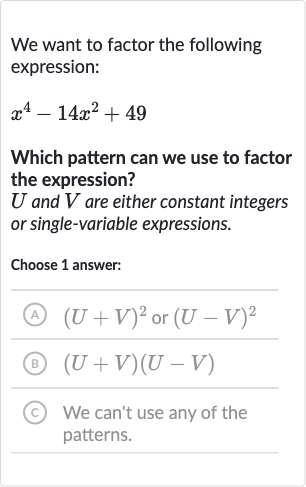AI tutor
Welcome to Bytelearn!
Let’s check out your problem:

We want to factor the following expression:Which pattern can we use to factor the expression? and are either constant integers or single-variable expressions.Choose answer:(A) or (B) (C) We can't use any of the patterns.
Full solution
Q. We want to factor the following expression:Which pattern can we use to factor the expression? and are either constant integers or single-variable expressions.Choose answer:(A) or (B) (C) We can't use any of the patterns.
- Rephrasing the problem: First, let's rephrase the "What pattern can be used to factor the expression ?"
- Identifying the structure: Identify the structure of the given expression: . Notice that it resembles the structure of a perfect square trinomial, which is or , where the first and last terms are perfect squares and the middle term is twice the product of the square roots of the first and last terms.
- Checking for perfect squares: Determine if the first term and the last term are perfect squares. The first term is a perfect square because . The last term is a perfect square because .
- Verifying the middle term: Check if the middle term fits the pattern of twice the product of the square roots of the first and last terms. The square root of is , and the square root of is , so twice the product of and is . Since the middle term is , it fits the pattern of a perfect square trinomial with a negative middle term, which corresponds to .
- Writing as a perfect square trinomial: Write the expression as a perfect square trinomial using the pattern , where is the square root of the first term and is the square root of the last term. In this case, and , so the factored form is .
More problems from Mean, median, mode, and range: find the missing number
QuestionGet tutor help
QuestionGet tutor help
QuestionGet tutor help
QuestionGet tutor help
QuestionGet tutor help
QuestionGet tutor help
QuestionGet tutor help
